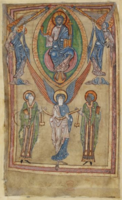
Matthew Paris, also known as Matthew of Paris, sometimes confused with the nonexistent Matthew of Westminster, was an English Benedictine monk, chronicler, artist in illuminated manuscripts, and cartographer who was based at St Albans Abbey in Hertfordshire. He authored a number of historical works, many of which he scribed and illuminated himself, typically in drawings partly coloured with watercolour washes, sometimes called "tinted drawings". Some were written in Latin, others in Anglo-Norman or French verse.
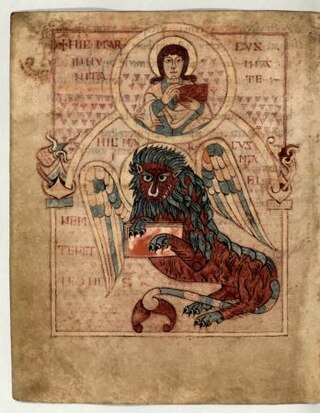
The Book of Cerne is an early ninth-century Insular or Anglo-Saxon Latin personal prayer book with Old English components. It belongs to a group of four such early prayer books, the others being the Royal Prayerbook, the Harleian prayerbook, and the Book of Nunnaminster. It is now commonly believed to have been produced sometime between ca. 820 and 840 AD in the Southumbrian/Mercian region of England. The original book contains a collection of several different texts, including New Testament Gospel excerpts, a selection of prayers and hymns with a version of the Lorica of Laidcenn, an abbreviated or Breviate Psalter, and a text of the Harrowing of Hell liturgical drama, which were combined to provide a source used for private devotion and contemplation. Based on stylistic and palaeographical features, the Book of Cerne has been included within the Canterbury or Tiberius group of manuscripts that were manufactured in southern England in the 8th and 9th centuries AD associated with the Mercian hegemony in Anglo-Saxon England. This Anglo-Saxon manuscript is considered to be the most sophisticated and elaborate of this group. The Book of Cerne exhibits various Irish/Celtic, Anglo-Saxon, Continental, and Mediterranean influences in its texts, ornamentation, and embellishment.

British Library, MS Cotton Tiberius C. II, or the Tiberius Bede, is an 8th-century illuminated manuscript of Bede's Historia ecclesiastica gentis Anglorum. It is one of only four surviving 8th-century manuscripts of Bede, another of which happens to be MS Cotton Tiberius A. XIV, produced at Monkwearmouth–Jarrow Abbey. As such it is one of the closest texts to Bede's autograph. The manuscript has 155 vellum folios. This manuscript may have been the Latin text on which the Alfredian Old English translation of Bede's Ecclesiastical History was based. The manuscript is decorated with zoomorphic initials in a partly Insular and partly Continental style.

The Vespasian Psalter is an Anglo-Saxon illuminated psalter decorated in a partly Insular style produced in the second or third quarter of the 8th century. It contains an interlinear gloss in Old English which is the oldest extant English translation of any portion of the Bible. It was produced in southern England, perhaps in St. Augustine's Abbey or Christ Church, Canterbury or Minster-in-Thanet, and is the earliest illuminated manuscript produced in "Southumbria" to survive.

The Benedictional of St Æthelwold is a 10th-century illuminated benedictional, the most important surviving work of the Anglo-Saxon Winchester School of illumination. It contains the various pontifical blessings used during Mass on the differing days of the ecclesiastical year, along with a form for blessing the candles used during the Feast of the Purification. The manuscript was written by the monk Godeman at the request of Æthelwold, Bishop of Winchester.
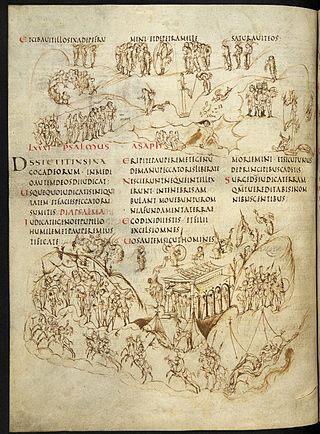
The Utrecht Psalter is a ninth-century illuminated psalter which is a key masterpiece of Carolingian art; it is probably the most valuable manuscript in the Netherlands. It is famous for its 166 lively pen illustrations, with one accompanying each psalm and the other texts in the manuscript. The precise purpose of these illustrations, and the extent of their dependence on earlier models, have been matters of art-historical controversy. The psalter spent the period between about 1000 to 1640 in England, where it had a profound influence on Anglo-Saxon art, giving rise to what is known as the "Utrecht style". It was copied at least three times in the Middle Ages. A complete facsimile edition of the psalter was made in 1875, and another in 1984 (Graz).

The Stowe Psalter is a psalter from the "2nd or 3rd quarter of the 11th century", at the end of Anglo-Saxon art. The text includes the Gallican version of the Psalms, followed by the Canticles with an interlinear Old English gloss.

The Regularis Concordia was the most important document of the English Benedictine Reform, sanctioned by the Council of Winchester in about 973.

The Athelstan Gospels, or British Library, Cotton MS Tiberius A. ii is a late 9th or early 10th-century Ottonian illuminated Gospel book which entered England as a gift to King Athelstan, who in turn offered it to Christ Church, Canterbury. It is also referred to as the Coronation Gospels on account of an early modern tradition that it had been used as an oath-book at English coronations.

The Psalter of Oswald also called the Ramsey Psalter is an Anglo-Saxon illuminated psalter of the last quarter of the tenth century. Its script and decoration suggest that it was made at Winchester, but certain liturgical features have suggested that it was intended for use at the Benedictine monastery of Ramsey Abbey in Huntingdonshire, or for the personal use of Ramsey's founder St Oswald.
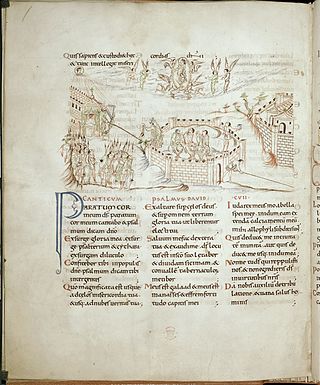
The Harley Psalter is an illuminated manuscript of the second and third decades of the 11th century, with some later additions. It is a Latin psalter on vellum, measures 380 x 310 mm and was probably produced at Christ Church, Canterbury. The most likely patron of such a costly work would have been the Archbishop of Canterbury at the time, possibly Æthelnoth, who was consecrated in 1020 and remained at Canterbury until 1038.
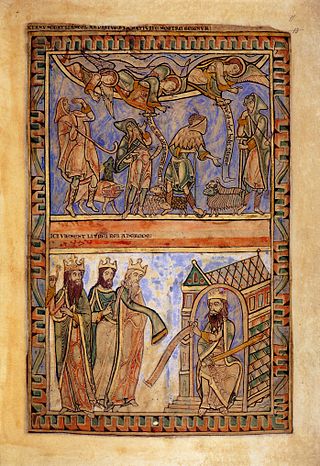
The Winchester Psalter is an English 12th-century illuminated manuscript psalter, also sometimes known as the Psalter of Henry of Blois, and formerly known as the St Swithun's Psalter. It was probably made for use in Winchester, most scholars agreeing that the most likely patron was the Henry of Blois, brother of Stephen, King of England, and Bishop of Winchester from 1129 until his death in 1171. Until recent decades it was "a little-studied masterpiece of English Romanesque painting", but it has been the subject of several recent studies.
Handbook for a Confessor is a compilation of Old English and Latin penitential texts associated with – and possibly authored or adapted by – Wulfstan (II), Archbishop of York. The handbook was intended for the use of parish priests in hearing confession and determining penances. Its transmission in the manuscripts seems to bear witness to Wulfstan's profound concern with these sacraments and their regulation, an impression which is similarly borne out by his Canons of Edgar, a guide of ecclesiastical law also targeted at priests. The handbook is a derivative work, based largely on earlier vernacular representatives of the penitential genre such as the Scrifboc and the Old English Penitential. Nevertheless, a unique quality seems to lie in the more or less systematic way it seeks to integrate various points of concern, including the proper formulae for confession and instructions on the administration of confession, the prescription of penances and their commutation.

The Anglo-Saxon Chronicle is a collection of annals in Old English, chronicling the history of the Anglo-Saxons. The original manuscript of the Chronicle was created late in the 9th century, probably in Wessex, during the reign of Alfred the Great. Multiple copies were made of that one original and then distributed to monasteries across England, where they were independently updated. In one case, the Chronicle was still being actively updated in 1154.

The Westminster Psalter, British Library, MS Royal 2 A XXII, is an English illuminated psalter of about 1200, with some extra sheets with tinted drawings added around 1250. It is the oldest surviving psalter used at Westminster Abbey, and is presumed to have left Westminster after the Dissolution of the Monasteries. It joined the Old Royal Library as part of the collection of John Theyer, bought by Charles II of England in 1678. Both campaigns of decoration, both the illuminations of the original and the interpolated full-page drawings, are important examples of English manuscript painting from their respective periods.

Derek Howard Turner was an English museum curator and art historian who specialised in liturgical studies and illuminated manuscripts. He worked at the British Museum and the British Library from 1956 until his death, focusing on exhibitions, scholarship, and loans.
Virtual Mappa (VM) (https://sims2.digitalmappa.org/36) is a collaborative digital humanities project that collects, annotates and networks medieval mappamundi using the Digital Mappa resource. The project is open access, hosted and published by the Schoenberg Institute for Manuscript Studies at the University of Pennsylvania, and in collaboration with the British Library. The project is currently directed by Martin Foys and Heather Wacha, and continues to grow as new contributors join the project and edit new medieval maps.









